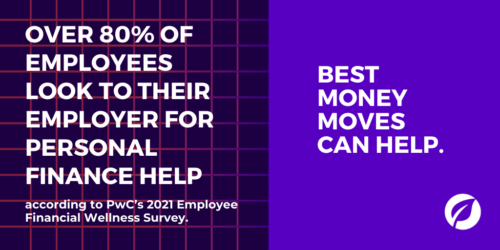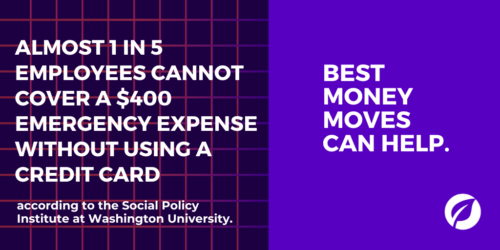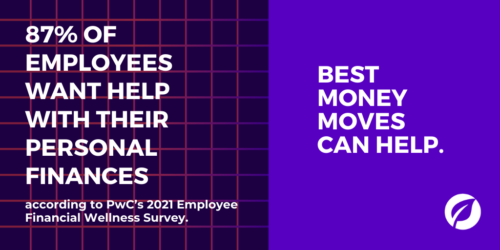The top 12 workplace trends of 2022. These 12 trends could be the key to keeping workforces focused, productive and successful in 2022.
COVID-19 has shifted workplace priorities — many of which have become the new normal for 2022. Staying ahead of workplace trends can help your team attract and retain top talent, and position your team for success in a “post-pandemic” future.
Here are the top workplace trends of 2022 and how your company can keep up and stand out.
Plus, don’t miss the full 2022 Workforce-Workplace Forecast, hosted by Best Money Moves Founder/CEO Ilyce Glink and trend-spotter CEO Joyce Gioia of the Herman Group do a deep dive into Gioia’s 2022 Workforce-Workplace Forecast.
Top 12 workplace trends for 2022
1. The Great Resignation continues
Even two years into the Covid-19 pandemic, employees and positions are still in flux and many are reconsidering their careers. Around 1 in 3 Americans under 40 say that they’ve considered a career change since the pandemic began, according to a Washington Post-Schar School poll.
Today’s hybrid labor market enables people and positions to continue to shift. For example, people once who endured low wages and poor work conditions are increasingly looking toward remote positions for a better work experience.
Standout solution 1: Conduct “stay interviews”
To combat this employee exodus, employers have started conducting “stay interviews” to see what makes employees stay, and conversely, what might make them leave. Understanding the hearts and minds of your most loyal employees is crucial to talent retention and acquisition, and stay interviews help employers gain such insights. Find out what your company does well and where it may need some change, from the people that understand your organization best: your employees themselves.
2. Rewrite the rules to support hybrid work
The pandemic has changed the workplace as we once knew, and offices may never be the same. Around 90% of U.S. employees want to work from home at least once a week, according to a Prudential survey, and almost 70% want to be able to work from home even after the pandemic. Many companies have embraced the hybrid work model as here to stay; however, a hybrid work model requires traditional rules and systems to be rewritten.
Standout solution 2: Offer your team as much flexibility as you’re able
The flexibility that was once wishful-thinking is now accessible and within reach. Allow employees to create their own work-life balance. Perks like flexible hours and virtual dress codes can go a long way, especially for employees balancing work and caregiving responsibilities.
3. Covid fatigue remains in the workplace
Employees (both remote and in-person) continue to struggle with Covid fatigue or workplace fatigue largely due to Covid-related changes. Leaving fatigue unaddressed can hurt employee mental health and lead to burnout and higher attrition.
Covid fatigue manifests in different ways. For example, nearly 50% of remote employees reported having “Zoom fatigue,” or a high degree of exhaustion from daily video calls, which can cause chronic stress and anxiety. In-person employees are stretched thin from extra duties as vaccine and mask enforcers; moreover, they remain the most vulnerable to customer abuse and getting ill.
Standout solution 3: Ask employees what they need to feel supported
Encourage recurring feedback on how the pandemic has affected all employees and how you can further address their needs. Some employers have offered therapy resources and meditation apps; others have instituted new policies to protect workers from customers who may be more aggressive than normal due to their own pandemic stress. Work collaboratively with your employees to find what they feel they need most.
4. Customer service suffers: burned-out employees
Consumers are increasingly frustrated with the poor customer service during the pandemic. Almost 80% of consumers said they’ve had to contact customer service multiple times for one issue and 55% said their issue never got resolved, according to an NBC and Telemundo survey.
However, poor customer service can be a product of employee burnout. With employees leaving, customer service teams are largely understaffed; simultaneously, there’s a lack of hiring, thus leaving the burden of work on remaining employees. About 80% of employees say they are burned out, said a Deloitte survey, and nearly 70% feel their employers are not doing enough to prevent or alleviate burnout.
Standout solution 4: Put care and connection first for customers and employees
Customers don’t like when businesses are unreachable and unresponsive but employees also struggle to manage the influx of customer service calls. Employers can ease responsibilities for employees and satisfy customers through callback technology to minimize wait times or data analytics to anticipate customer needs.
5. Expanded definition of “total rewards”
Total rewards are more than just “total compensation;” rather, total rewards are the combined benefits, rewards, compensation, flexibility and opportunities that employees receive from their employer.
On an individual level, total rewards can include benefits and growth opportunities salient to an employee like career growth, positive culture or healthy work-life balance. Total rewards have been a driving force for many employees changing jobs during the pandemic, even if it means taking a pay cut.
Standout solution 5: Offer creative, tailored rewards
Get creative and see what additional benefits may give your company a talent strategy boost. Some employers have adopted on-site childcare to make up for the childcare reductions during Covid-19; others leverage free food and on-site childcare opportunities. See what changes may be most beneficial to your workforce and overall talent strategy.
6. Unconscious bias remains alive and well
About 50% of Black and brown women said that they’ve been mistaken for administrative or custodial staff, and name bias continues to influence hiring practices. While senior leaders feel they’re doing their best with diversity, equity and inclusion (DEI) commitments, employees don’t necessarily agree. This disconnect highlights an opportunity for companies to understand and improve their DEI shortcomings.
Standout solution 6: Find appropriate DEI soundboards, without tokenism
When making company decisions, take the extra step to incorporate a DEI lens. Leverage the experience of employees from many different backgrounds to check for potential bias and other forms of marginalization. However, when creating a soundboard, be mindful not to tokenize employees for their identities — no single person alone can represent an entire group.
7. Employers show increased concern for employee wellness & wellbeing
Employers have grown increasingly committed to employee wellbeing during the pandemic. However, employers must take a comprehensive approach to wellness and wellbeing beyond just the physical. Overall wellbeing incorporates the mental, emotional and financial wellness of all employees.
Standout solution 7: Invest in financial wellness resources
Like mental health resources, financial wellness is a benefit gaining popularity. Money is a leading cause of stress among employees, and many want help. Over 80% of employees say they look toward their employer for personal finance help, beyond building retirement and emergency expense safety nets. Financial wellness programs are a personalized solution to help employees address their biggest financial stresses, whether it be mortgage and car loans or improving their credit score.

Learn how financial wellness can better employees while saving your company money with Best Money Moves.
8. Learning, development and communication continue to evolve
Slack, Zoom and other technologies have transformed how we learn and work together, especially in a multi-generational workforce. Everyone has different communication preferences, so make sure teams know how to stay in touch and engage with each other in a meaningful way.
Standout solution 8: Find creative ways for employees to learn and engage
Although Covid-19 has limited the ways in which we connect, find creative opportunities for employee collaboration and engagement. Some companies are using augmented reality (AR) technology to facilitate communication and development. Companies across various industries have reported that using AR technology improved employee engagement and productivity (32%), according to IBM.
9. Employers refocus on the employee experience
Part of employee wellbeing is focusing on the employee experience, whether working in-office or at home. The work environment is critical to employee wellbeing, and every touchpoint with employees is important. How do you respond to resumes you like and don’t like? What is it like to work for your company? How is the onboarding process?
Standout solution 9: Invest in your workforce’s specific needs
The pandemic has opened the door to widespread changes, which McKinsey analysts have dubbed the “new possible.” Work to understand your employees’ specific needs and try to meet them. Maybe your employees could use on-site childcare or gym reimbursements — survey your workforce and try to best meet their needs.
10. Employers seek recognition as an employer of choice
Employers of choice are highly desirable places to work, often known for their culture, benefits and more. Employers of choice generally get first dibs on the best candidates as they look for value, respect and reciprocity. So, employer of choice status can give your company a competitive edge, particularly over less adaptive companies.
Here are several ways companies of all sizes can obtain employer of choice status:
- See what employees think about your organization on company review sites (e.g., Glassdoor.com and Vault Rankings)
- Apply to the variety of U.S. business awards
- Compare your organization’s practices to industry-leading standards and benchmarks (e.g., workplace safety, labor rights, sustainability and etc.)
Standout solution 10: Create your own company culture
Crafting an authentic company culture can help distinguish you from competitors, while convincing top talent why they should choose you. What is it like working at your company? What are the company standards and how can the company be improved? For example, can you offer more tailored benefits or update company values?
11. Diversity on boards continues to rise
Following the racial justice movements of 2020, board diversity has increased. Women, of all races, have received more board representation. The number of S&P 500 Black Director appointees has increased by nearly 200%, according to ISS Corporate Solutions, Inc.
Standout solution 11: Integrate diversity at all levels of employment
To keep the momentum going, companies should work to integrate diversity at all levels of employment — from entry-level and middle-management to C-suite execs and board members. This takes a holistic approach to diversity in the workplace, by not concentrating diversity at a specific level of employment.
12. Big data in HR marches on
Big data, or technology that helps teams process large quantities of information, is becoming an integral part of HR practices and people analytics. Today, big data is commonly used to streamline hiring processes and payroll and link employee data to company metrics. Big data can also help inform key business decisions by providing quantitative evidence to qualitative matters.
Standout solution 12: Vow to use personal data responsibly
The rise of remote work and e-commerce has given companies abundant access to employee and consumer personal data; unfortunately, some companies violate privacy boundaries to obtain such data and it’s an increasing concern among Americans.
Over 95% of U.S. consumers say more should be done to ensure companies protect consumer privacy, according to Consumer Reports’ Digital Lab. Beyond making sure company data is secure, it is equally important to ensure that employees’ personal data is used responsibly and ethically.
Looking for a financial wellness solution fit for all? Check out Best Money Moves!
Best Money Moves is a financial wellness solution designed to help dial down employees’ most top-of-mind financial stresses. As a comprehensive financial wellbeing solution, Best Money Moves offers 1:1 money coaching, budgeting tools and other resources to improve employee financial wellbeing. Our AI platform, with a human-centered design, is easy to use and fit for employees of any age.
Whether it be college planning or securing a mortgage, Best Money Moves can guide employees through the most difficult financial times and topics. Our dedicated resources, partner offerings and 700+ article library make Best Money Moves a leading benefit in bettering employee financial wellness.
To learn more about Best Money Moves Financial Wellness Platform, let’s schedule a call. Contact us and we’ll reach out to you soon.










